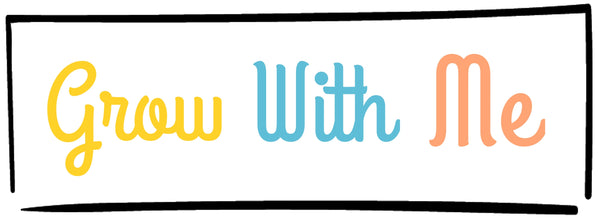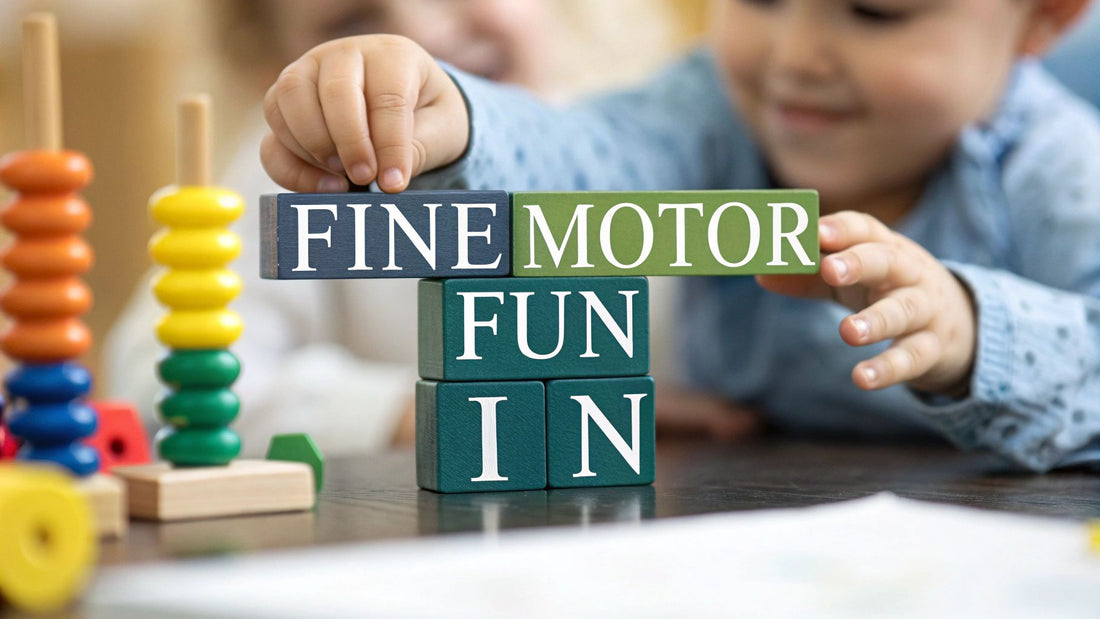
Fun Fine Motor Skills Development Activities
Share
Fine motor skills development activities are simply playful tasks that help strengthen the tiny muscles in your child's hands and wrists. Things like stacking blocks or scribbling with a crayon might just look like fun and games, but they’re actually critical for building the dexterity your little one will need for big-kid skills like writing their name and dressing themselves.
Why Tiny Hand Movements Matter So Much
Ever watch your toddler’s wobbly block tower come crashing down, or admire their very... abstract crayon art? Those moments are so much more than just playtime. They're the foundation for your child's future.
Fine motor skills are all about the coordinated movements of the small muscles in the hands, wrists, and fingers. Think of them as the building blocks for nearly every practical task your child will ever learn. From feeding themselves with a spoon to one day tying their own shoelaces, these abilities are what give children a real sense of independence and confidence.
When your baby figures out how to pick up a single pea, they’re practising the pincer grasp – the very same skill they’ll use down the line to hold a pencil correctly. It all connects.
The Link to Future Learning
Strong fine motor control isn't just about physical skill; it's deeply tied to brain development and getting ready for school. The ability to control their hand movements lets a child explore objects in a more complex way, which fires up their developing brain. This powerful connection between hands-on play and learning is why so many developmental activities for infants focus on simple grasping and reaching.
Worryingly, there's a growing conversation among teachers and developmental experts about a slip in these essential skills. Recent UK government figures back this up, showing a slight but noticeable dip in the number of two-year-olds hitting their fine motor milestones. For 2022-23, 92.6% of children were at or above the expected level, down from the previous year. This suggests we need to be more mindful of creating opportunities for this kind of development.
"Developing fine motor skills is about more than just physical ability; it's about giving a child the tools they need to interact with, learn from, and shape their world."
This infographic shows just how important this is, mapping the percentage of UK children with below-expected fine motor skills against primary school test scores over a decade.
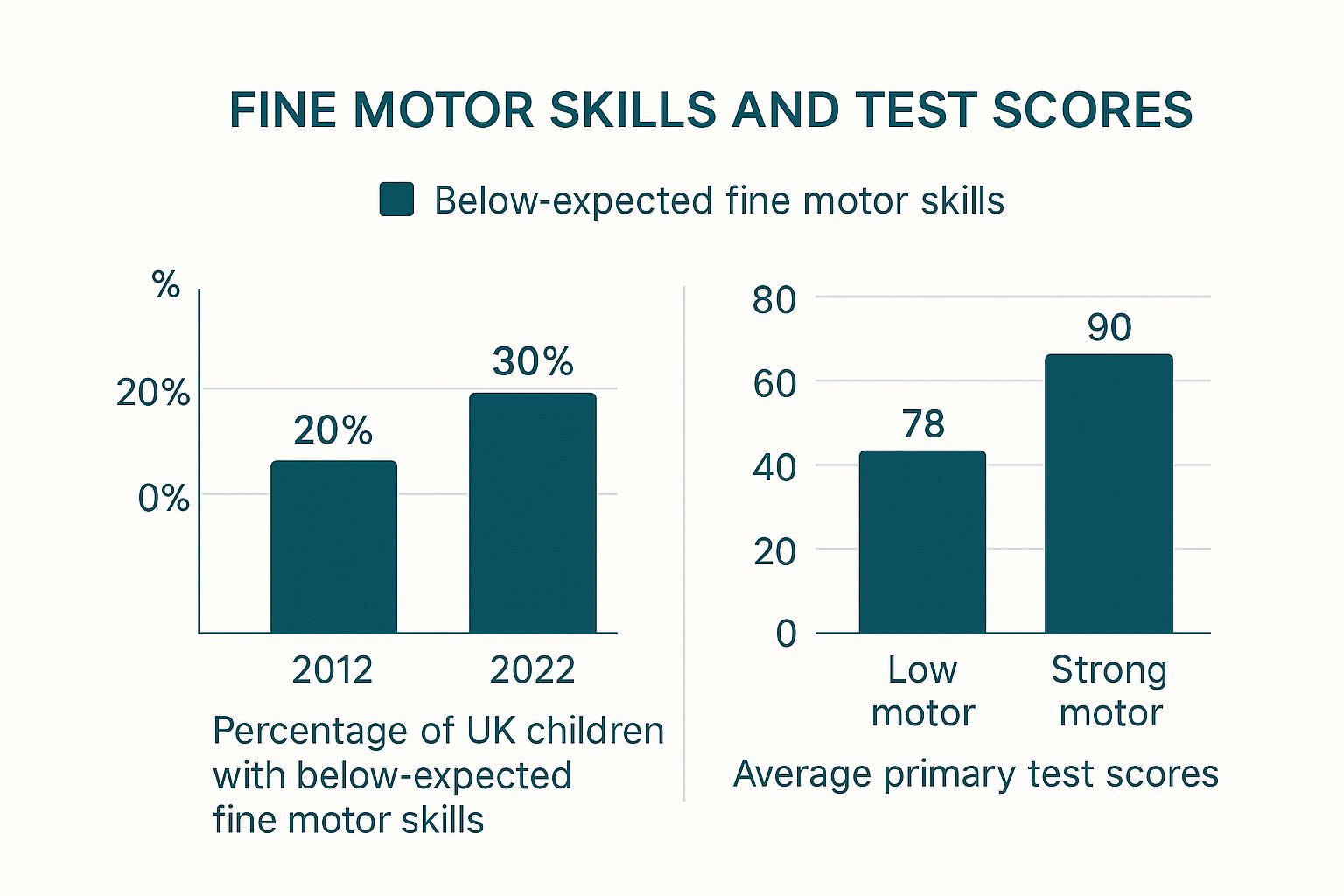
You can see the trend for yourself – as the percentage of children with underdeveloped motor skills creeps up, academic performance indicators tend to slide.
Setting the Stage for Success
Here’s the brilliant part: you don't need fancy toys or complicated lesson plans to support your child's fine motor development. It’s all about weaving simple, fun activities into your everyday routine.
The practical ideas we’re about to jump into are all designed to:
- Build up strength in their hands and fingers
- Sharpen hand-eye coordination
- Boost their problem-solving abilities
By making time for this kind of purposeful play, you're making a huge investment in your child's future. You’re setting them up to thrive, not just in the classroom, but in life itself.
Building Blocks of Dexterity for Babies
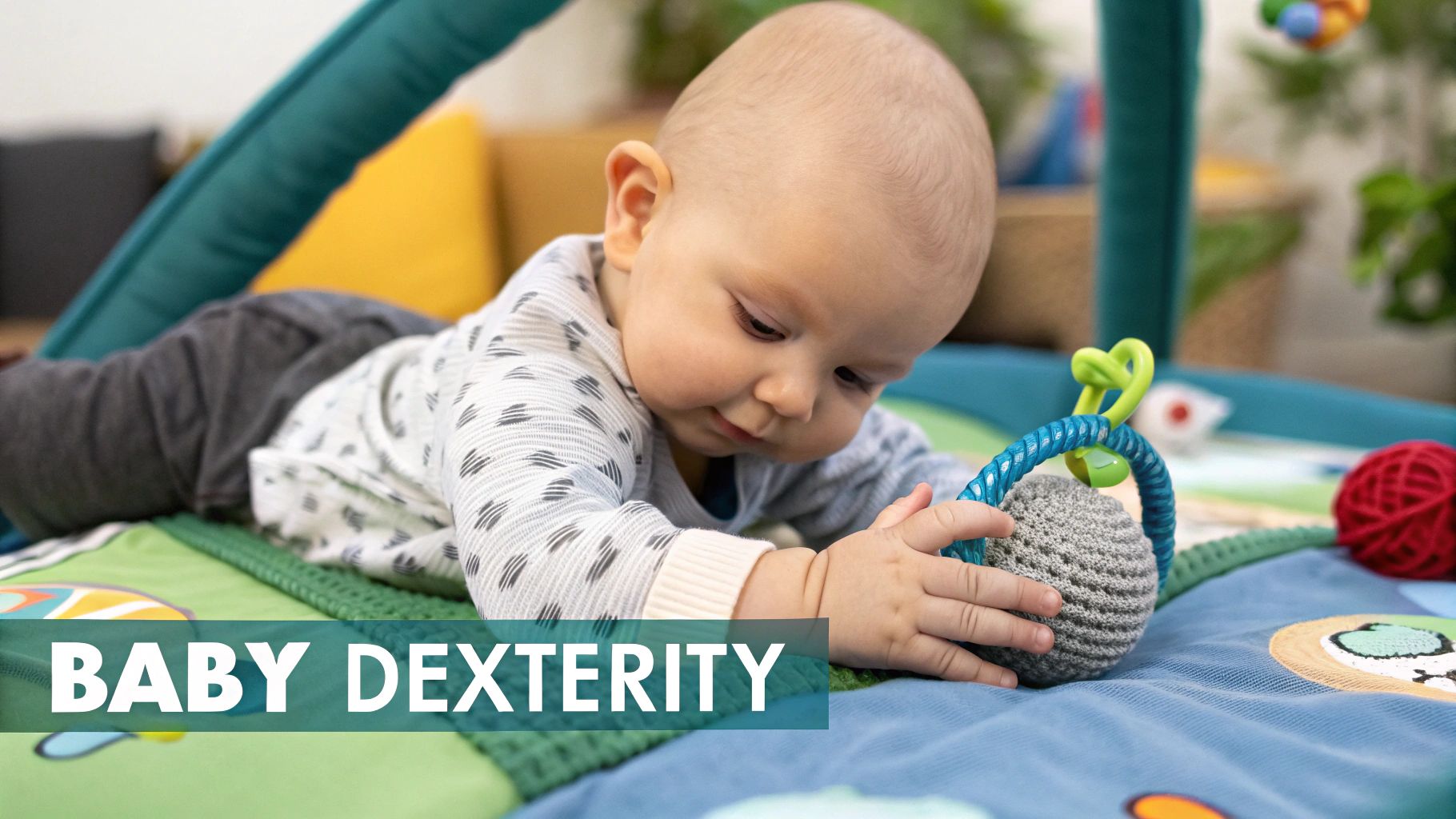
With our littlest ones, developing fine motor skills isn't about sitting down for structured lessons. It all starts with simple, sensory discoveries. Your baby's brain and body are growing at a truly astonishing rate in that first year, and their hands are one of their main tools for figuring out the world. You can support this incredible growth by weaving gentle, engaging moments into your everyday life.
These early experiences aren't really "activities" in the traditional sense. It's more about creating a world that’s rich with opportunities to touch, grasp, and explore. Every single time your baby wraps their tiny hand around your finger or clutches a soft toy, they're building crucial connections in their brain and strengthening all those little muscles. This is the groundwork for all the more coordinated movements that will come later.
Tummy Time Explorations
We all know tummy time is fantastic for building core and neck strength, but it's also a golden opportunity for their hands. Don't just pop your baby on a mat and walk away; turn it into a little interactive game.
Try placing one eye-catching toy—something with high contrast or a gentle rattle sound—just within their sight but slightly out of reach. This simple setup encourages them to push up, shift their balance, and eventually stretch out an arm to grab for it. That tiny act of reaching and trying to grasp is a huge workout for their developing hand-eye coordination.
Here are a few simple ideas to make tummy time more engaging:
- Textured Mats: A playmat with different textures is a game-changer. Think crinkly patches, soft fleecy bits, or silky ribbons they can pat and feel with their palms.
- Safe Mirrors: A baby-safe, unbreakable mirror is captivating. It encourages them to lift their head and reach out to touch the "other baby" they see.
- Rolling Toys: A soft ball that rolls away slowly can get them to track it with their eyes and attempt a reach.
Grasping and Sensory Play
One of the first things you'll notice is your baby's grasping reflex – it’s there from day one. You can help them turn that instinct into a deliberate skill by offering a variety of safe, interesting objects to hold. Look for things with different shapes, textures, and even weights.
A lightweight wooden rattle feels completely different from a soft silicone teether or a crinkly bit of fabric. Each one offers unique sensory feedback. When you gently place an object in their hand, you’re helping them learn to adjust their grip and understand the world through touch. If you want more inspiration, check out these wonderful sensory play ideas for babies to get their senses firing.
The key thing to remember at this age is that variety trumps complexity. Simply swapping the toy they're holding can introduce a whole new learning experience for their hands and brain.
Once you hit the six-month mark and start introducing solids, mealtimes suddenly become another brilliant arena for fine motor practice. Letting your baby try to pick up soft, dissolvable puffs or little pieces of cooked carrot helps them work on that all-important pincer grasp—using their thumb and forefinger together. Yes, it will be messy! But this self-feeding practice is absolutely invaluable for building both dexterity and independence.
Hands-On Creative Play for Toddlers
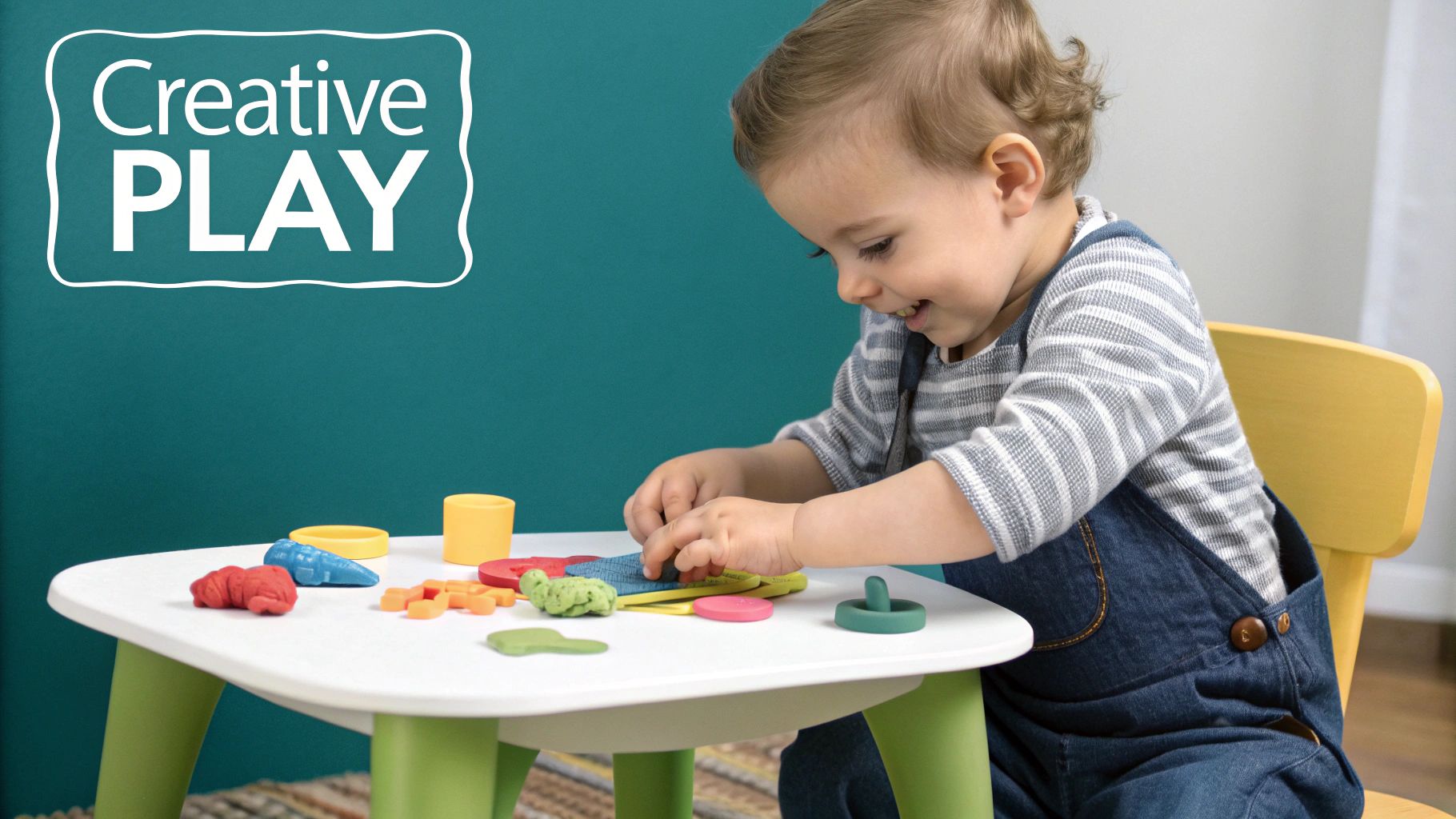
Once your baby becomes a toddler, their natural curiosity just explodes. It's an amazing phase, and it’s the perfect time to bring in hands-on, creative activities that secretly build their fine motor skills while they think they’re just playing.
The best part? You really don't need a house full of expensive 'educational' toys. I’ve found that many of the most effective tools are already hiding in the kitchen cupboards or craft drawer.
Getting comfortable with a bit of mess is all part of the magic here. Activities like finger painting or squishing modelling dough aren't just about creating a masterpiece for the fridge. They give your toddler incredible sensory feedback, building the foundational strength and coordination they'll need for more complex things down the line.
This kind of play is more crucial than ever. A recent UK survey of educators brought a worrying trend to light: 77% of primary teachers have seen a decline in children’s fine motor abilities since 2020. This really shows how vital it is for us, as parents, to actively encourage these skills at home. You can read the full report from the 2025 YouGov survey to understand its impact on education.
Transforming Everyday Items into Learning Tools
Let's look at a few classic activities and break down why they work so well for developing fine motor skills. These simple ideas are brilliant little workouts for tiny hands.
Threading Chunky Pasta
Find some uncooked, tube-shaped pasta (penne or rigatoni are perfect) and a shoelace. Just tie a big knot in one end and show your toddler how to thread the pasta pieces on. Easy.
- Why It Works: This is a fantastic way to develop bilateral coordination—that’s the skill of using both hands together for different jobs. One hand has to hold the lace steady while the other carefully guides the pasta. It’s the same skill they’ll eventually use to do up a zip.
Modelling Dough Exploration
Rolling, squishing, pinching, and poking modelling dough is a childhood staple for a good reason. You can level it up by giving them child-safe tools like plastic cutlery or a little rolling pin.
- Why It Works: This strengthens all those tiny muscles in their hands and fingers. Every single squeeze and roll builds the hand strength they’ll need for a proper pencil grip and the stamina to write later on.
Remember, it’s always about the process, not the final product. Just let them explore and enjoy the sensory experience instead of trying to make a perfect little snowman. For more inspiration on engaging their senses, check out our guide full of creative sensory play ideas for toddlers.
Unleashing Creativity with Paper and Paint
Getting arty isn't just about self-expression; these activities are absolutely packed with fine motor benefits.
Paper Tearing Collage
Instead of reaching for the scissors, just give your toddler some colourful paper and let them have at it. They can then use a glue stick to stick the torn pieces onto a bigger sheet, creating a gorgeous mosaic.
- Why It Works: Tearing paper requires a strong pincer grasp (using the thumb and index finger) and strengthens the arch of the hand. It’s a surprisingly effective workout that gets their fingers ready for more precise movements.
Finger Painting Fun
A big sheet of paper and some non-toxic, washable finger paints are all you need for this one. Encourage them to draw lines and dots with individual fingers, or even use their whole palm to make prints.
- Why It Works: This activity is brilliant for promoting finger isolation—the ability to move one finger at a time. This is a crucial skill for everything from typing on a keyboard to one day playing a musical instrument.
By weaving these simple, creative moments into your weekly routine, you’re making a huge difference to their physical development. If you're looking to build up your toolkit of playful learning ideas, you can find more fun fine motor skills development activities for kids.
Everyday Tasks That Build Fine Motor Skills
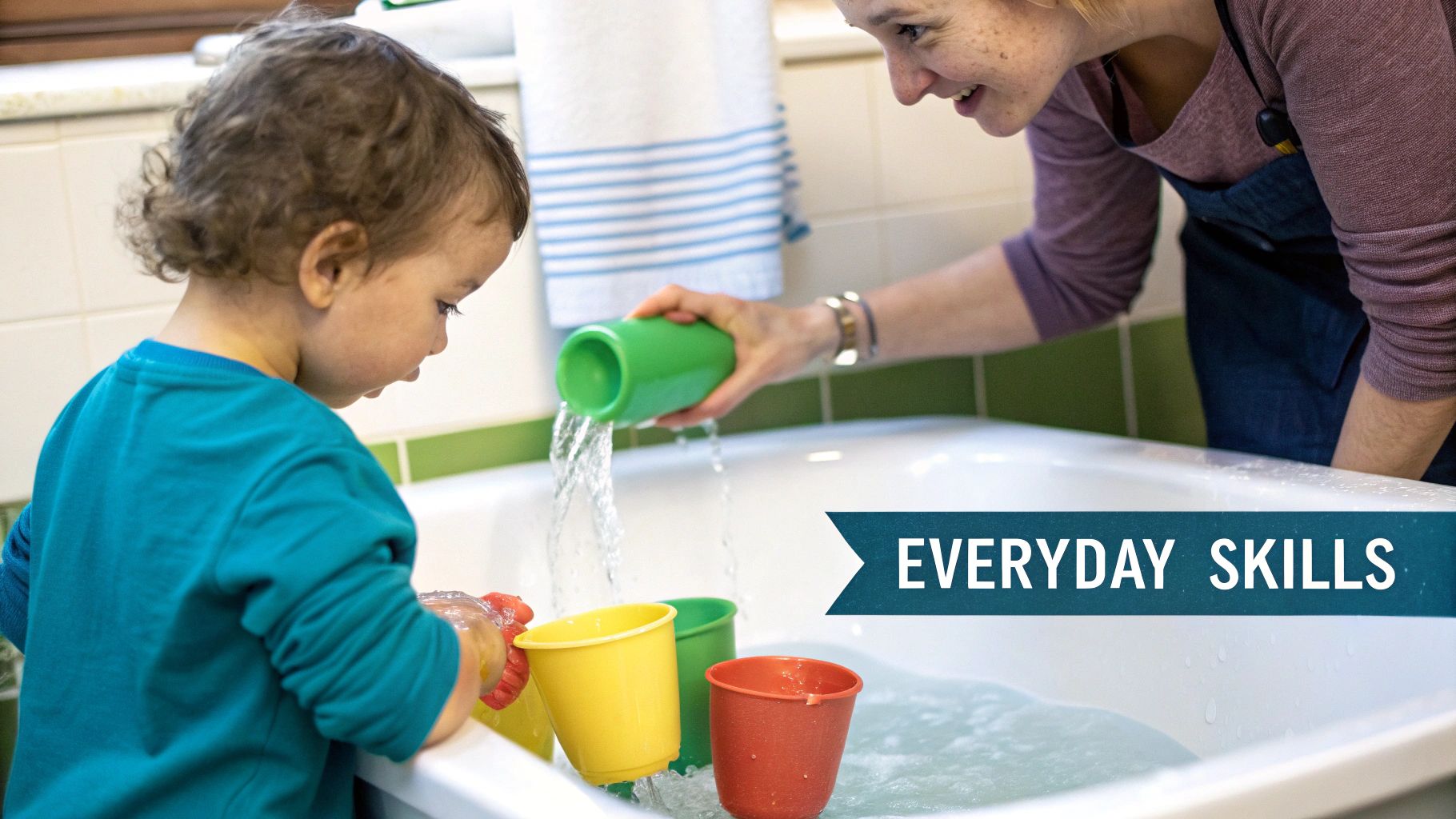
While structured, creative play is brilliant, you really don't need to get the paints out every single day to support your toddler. Believe it or not, some of the most powerful opportunities for fine motor skill development are already built right into your daily routine.
When you invite your little one to "help" with simple household tasks, you're turning what might seem like mundane moments into incredibly valuable practice sessions. This approach does so much more than just build dexterity; it nurtures a real sense of independence and competence.
I've seen it time and again—when a toddler successfully manages to scoop their own yoghurt or helps put away their socks, their face just lights up. They feel so proud and capable. It’s a wonderful way to boost their confidence while strengthening those crucial hand and finger muscles.
Of course, this does require a healthy dose of patience from us parents. Yes, tasks will take longer. And yes, they will probably be messier! But the developmental payoff is absolutely huge. The key is to see these moments not as chores, but as shared learning experiences.
Turning Chores into Skill-Building Games
With a little reframing, you can find fine motor workouts everywhere. The kitchen, the bedroom, and even the bathroom are filled with chances for your toddler to practise everything from their hand-eye coordination to that all-important pincer grasp.
Here are a few practical examples to get you started:
- Mealtime Helpers: Let them use a small spoon to scoop things like peas or yoghurt. You can also hand them a chunk of banana to peel themselves—just starting it for them makes it manageable.
- Dressing Practice: When it's time to get dressed, let them try to pull up a big zip on their jacket or fasten a large, chunky button. Velcro shoes are another fantastic first step towards dressing independence.
- "Helping" with Laundry: My little one loves this one. Give them a pile of socks to pull apart and put into the basket. This simple pulling motion is a surprisingly good hand-strengthener.
These tasks require concentration and control, sneakily building skills while your toddler just thinks they’re being a fantastic grown-up helper.
A quick tip: always adapt tasks for little hands. A big, chunky button is far less frustrating than a tiny one, and a small, lightweight jug is perfect for pouring practice during bath time. Start simple and make a big fuss about their effort, not just the result.
Bath Time and Tidying Up Fun
Even winding down for the day can be a chance for practice. Bath time, in particular, is a perfect, low-stakes environment for exploring fine motor skills.
Give them a few cups for pouring water back and forth, or some squeeze toys that require them to use their hand muscles to squirt water. These simple actions build hand strength and help them get an intuitive feel for cause and effect.
In the same way, tidying up can become a game of picking up small toys one by one and placing them into a basket. This is excellent practice for grasping and releasing objects with real control.
For an extensive collection of ideas, check out these fun, practical activities to improve fine motor skills. By weaving these small actions into your routine, you create a rich environment where learning just happens naturally, turning everyday moments into major milestones.
How Early Motor Skills Shape Future Success
It’s easy to dismiss threading pasta or squishing modelling dough as just another way to fill a rainy afternoon. But what if I told you that these simple, playful moments are one of the most powerful investments you can make in your child's future? The link between those tiny hand movements and later success is far stronger than most of us ever imagine.
Every time your toddler focuses intently on placing one block on top of another, they’re doing more than just building a tower. They’re forging crucial pathways in their brain. This concentrated effort strengthens their ability to concentrate, problem-solve, and stick with a challenge—the very skills they'll need later to learn to read, tackle a tricky maths problem, or navigate friendships at school.
The Bridge to School and Beyond
And this isn't just a nice theory; the long-term benefits are backed by solid research. A compelling study from the University of Surrey and Birkbeck followed over 9,000 preschool children in the UK. The results were clear: children who regularly drew and built things at ages 2, 3, and 4 had statistically higher GCSE scores at age 16.
What's more, they also had fewer behavioural issues, including reduced ADHD symptoms. You can dive into the fascinating details of how early drawing and building skills link to education on surrey.ac.uk. It goes to show that encouraging fine motor skills development activities isn't just about getting them ready for handwriting. It’s about nurturing the whole child.
The dexterity a child develops through hands-on play translates directly into cognitive control. Think about it: a child who can carefully manipulate a small toy is also learning how to control their focus, manage their impulses, and think through a problem step-by-step.
A Foundation for Lifelong Confidence
At the end of the day, isn't the goal to raise confident, capable people? When children start to master the physical world—whether by zipping up their own coat or pouring their own juice—they gain a powerful sense of independence and self-belief. They learn, through trial and error, that they can influence their environment and achieve their goals.
This foundational confidence, built through thousands of tiny, successful hand movements, is perhaps the greatest gift of all. The activities we’ve explored are about so much more than just developing skills. They're about empowering your child to become a curious, resilient, and successful learner for life. Every moment spent playing is a step toward that bright future.
Your Questions Answered
As you watch your little one grow, it’s only natural to have questions. Seeing them try to grasp a toy or clumsily pick up a piece of food can bring up all sorts of thoughts about their development. I get asked about fine motor skills all the time, so I’ve pulled together some of the most common queries to give you a bit of clarity and reassurance.
Think of this as a quick chat over a cuppa, where we can tackle those nagging questions and help you feel more confident in supporting your child's amazing journey.
Fine Motor vs. Gross Motor Skills: What’s the Difference?
It's easy to get these two confused, but they’re quite different. Imagine building with LEGO: gross motor skills are what let your child sit up straight and stable on the floor, while fine motor skills are what they use to click those tiny bricks together.
- Gross motor skills are the big ones. They use the large muscles in the arms, legs, and torso for movements like crawling, running, jumping, and climbing. This is all about strength and stability.
- Fine motor skills are all about precision. They involve the small, intricate muscles in the hands, fingers, and wrists for delicate jobs like picking up a raisin, holding a crayon, or turning a page in a book.
The two are completely intertwined. A child needs good core strength (a gross motor skill) to be able to sit steady and concentrate on a tricky task like threading beads (a fine motor skill).
Should I Be Worried About Developmental Delays?
This is the big one, isn't it? First, let me say this: every single child develops at their own pace. Those milestone charts are just guides, not strict rules. It's incredibly common for a child to be a little behind in one area while they're rocketing ahead in another.
That said, you know your child best. Always trust your gut. If you’re noticing a significant delay across several skills, or if your little one seems to consistently struggle with or avoid using their hands, it’s worth a chat with your GP or health visitor. They can offer a proper assessment and, most importantly, give you peace of mind.
Key Takeaway: Try not to panic over small developmental wobbles. Look for consistent patterns or significant delays, and never, ever hesitate to ask a professional if you're feeling concerned.
Do I Need to Buy Special Educational Toys?
Absolutely not! While the toy aisle is full of amazing things, you really don’t need to spend a fortune. Some of the best fine motor skills development activities come from using simple, everyday items you already have lying around the house.
The real goal is to give your child plenty of chances to use their hands in new and interesting ways. Things like playing with modelling dough, tearing up old paper for a collage, or even just "helping" you stir the cake mix are brilliant workouts for their little finger muscles. It’s all about creativity and practice, not fancy gadgets.
How Does Screen Time Affect Fine Motor Skills?
This is a question I hear more and more. While screens definitely have their place, too much passive screen time can get in the way of fine motor development. Simply swiping a finger across a tablet doesn't provide the same rich, hands-on experience as stacking real blocks or squishing a piece of clay.
When children play with physical objects, they learn about pressure, texture, weight, and how things fit together in a 3D world. A screen just can't replicate that. The key, as with most things, is balance. Just make sure screen time isn't pushing out all the wonderful, messy, hands-on play that is so vital for building strong, capable hands.
Ready to make playtime both fun and developmental without the guesswork? The Grow With Me subscription box delivers stage-based, high-quality toys right to your door. Each kit is curated by experts to support your child's fine motor skills and cognitive growth, with beautiful wooden toys and sensory items they'll adore. Explore our boxes today.
